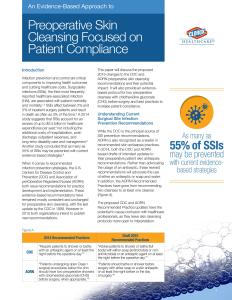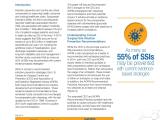Download complimentary copy of white paper here
Clorox Healthcare Discusses Proposed AORN/CDC Infection Prevention Recommendation Changes for Preoperative Skin Antisepsis
Improved Surgical Site Infection Prevention Strategies and Patient Outcomes Achieved Through Multiple Preoperative Chlorhexidine Gluconate Skin Cleanses
“Clorox Healthcare believes that the current infection prevention recommendations for preoperative skin antisepsis should not change. Additionally, the proposed recommendations are confusing, vague and have the potential to jeopardize patient care by leaving proper preoperative skin cleansing protocols open to interpretation,” said Kim LaFreniere, Ph.D., Associate Research Fellow, Clorox Healthcare, and co-author to the white paper.
It is also important to note that SSIs are a costly driver of patient morbidity and mortality, affecting between two and five percent of inpatient surgery patients and resulting in death as often as three percent of the time.1 “Our goal today when it comes to infection prevention should be a re-focusing on SSI-reduction research and evidence to inform whether any future recommendation changes are warranted. Any new recommendations should leverage clinical evidence to provide the clear and detailed recommendations healthcare professionals and practitioners need in order to deliver risk-reducing strategies to help prevent SSIs,” said Rosie Lyles, MD, MHA, MS, Head of Clinical Affairs, Clorox Healthcare, and co-author of the white paper.
In addition to discussing proven SSI prevention strategies, the white paper details their potential impact on compliance when it comes to protocol clarity and precision. It also includes an evidence-based recommendation in support of the existing recommendations for two preoperative CHG baths as part of a bundled approach to infection prevention.
Healthcare Facilities and Providers Are Now Challenged
A 2014 study suggests that SSIs account for an excess of up to $3.5 billion in healthcare expenditures per year,2 not including the additional costs of hospitalization, post-discharge outpatient expenses, and long-term disability care and management.3
“Based on the suggested changes available for public commentary, the new recommendations will likely not align with established and clinically-proven methods of CHG use. As a result, this may negatively impact SSI prevention protocol compliance and standardization in healthcare facilities in addition to overall care costs,” continued Lyles. “Infection control and prevention are critical components to improving health outcomes and curbing healthcare costs.”
The Solution is an Evidence-Based Approach to Infection Prevention
Clinical data supports that SSI prevention strategies can be enhanced with at least two preoperative baths using CHG as part of a bundled approach to reduce the risk of infection. A recent study concluded that as many as 55 percent of SSIs may be prevented with current evidence-based strategies.4 Though SSIs are often preventable, they remain a major threat to patient safety and quality of care.
Clorox Healthcare recommends specific steps to bolster SSI prevention strategies such as equipping healthcare professionals with proper education, ensuring patient access to CHG and providing them with clear instructions, including patient reminder systems, to enhance compliance.
The Clorox Healthcare white paper on skin antisepsis provides insight into:
- Evidence-Based Protocol for an SSI Prevention Strategy: Clinical data support that multiple preoperative CHG baths (at least two) are more effective than a single preoperative cleanse with an antiseptic or soap and water.5
- Best Practices to Enhance Patient Safety and Compliance: Recent studies collectively support the need for the standardization of SSI prevention strategies.6,7 Protocol compliance in any healthcare environment is critical, and in the case of SSI prevention strategies, patient safety hinges on the effectiveness of these practices.
Download a complimentary copy of the white paper “An Evidence-Based Approach to Preoperative Skin Cleansing Focused on Patient Compliance” at www.CloroxHealthcare.com/CHGSkinPrep.
Note: Patients should consult their doctor on the proper use of CHG for skin cleansing.
About Clorox Healthcare
Building on a century-long legacy in cleaning and disinfecting, Clorox HealthcareTM offers a wide range of products to help stop the spread of infection in healthcare facilities. From comprehensive surface disinfection, including advanced ultraviolet technology, to skin antisepsis, we are committed to providing efficacious solutions to the healthcare community. For preoperative skin cleansing, the 4% CHG Skin Cleansing Kit has all the essentials for two CHG cleanses. The kit includes key tools to aid with patient compliance, including a bilingual waterproof instruction card, a dedicated patient website, a direction for use video and a patient reminder system. For more information, visit www.CloroxHealthcare.com.
Media Contacts
Charles Butler, Clorox Professional Products Company, 510-220-6659, [email protected]
###
1 Centers for Disease Control and Prevention Hospital Infection Control Practices Advisory Committee. “Guideline for the prevention of surgical site infection, 1999.” Infection Control and Hospital Epidemiology 20(1999): 247-280.
2 Anderson DJ, Podgorny K, Berrios-Torres SI, et al. “Strategies to Prevent Surgical Site Infections in Acute Care Hospitals: 2014 Update.” Infection Control and Hospital Epidemiology 35.6(2014): 605-627.
3Anderson DJ, et al. “Strategies to Prevent Surgical Site Infections in Acute Care Hospitals.” Infection Control and Hospital Epidemiology 29.S1(2008): S51-S61.
4Umscheid CA, et al. “Estimating the Proportion of Healthcare-associated Infections that are Reasonably Preventable and the Related Mortality and Costs.” Infection Control and Hospital Epidemiology 32.3(2011): 101-114.
5 Edmiston CE, Okoli O, Graham MB, Sinski S, Seabrook GR. “Evidence for using Chlorhexidine Gluconate Preoperative Cleansing to Reduce the Risk of Surgical Site Infection.” AORN Journal 92.5(2010): 509-518.
6 Edmiston CE, et al. “Empowering the Surgical Patient: A Randomized, Prospective Analysis of an Innovative Strategy for Improving Patient Compliance to the Preadmission Showering Protocol.” Journal of the American College of Surgeons 219.2(2014): 256-264.
7 Johnson AJ, et al. “Chlorhexidine reduces infections in knee arthroplasty.” Journal of Knee Surgery 26.3(2013): 213-218.
Photo
Related Link
CloroxHealthcare.com/CHGSkinPrepRelated Documents
Co-Author Biography: Rosie D. Lyles, MD, MHA, MScCo-Author Biography: Kim LaFreniere, PhD






